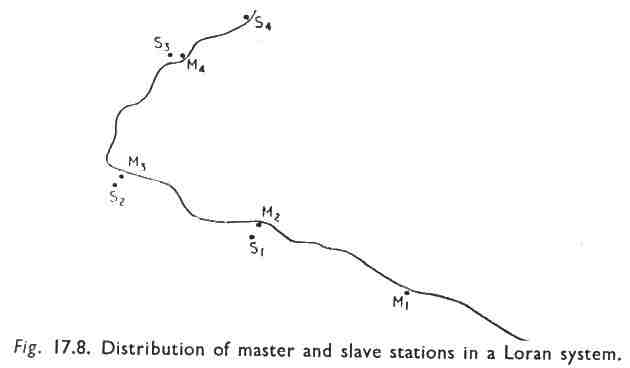Navigational Aids
Loran - AMES 700
(The Loman - Ames 23 was the designation given to the RAF Loran systems in North Africa which formed part of the European SS Loran system. It was identical to the Loran Ames Type 700, the Type 23 designation was introduced for security reasons)
|
Major system characteristics |
|
|
System type |
Hyperbolic navigation system |
|
Frequency band |
1.7 - 2 Mc/s |
|
Pulse length |
40 uSec |
|
Cycle repetition frequency |
25 c/s |
The text that follows in this section is taken from "The Services Textbook of Radio, Volume 7, Radiolocation Techniques" by Brig. J. D. Haigh, O.B.E., M.A., M.I.E.E., Edited by the staff of "Wireless World", H.M.S.O., London, 1960 pages 249 - 250. This volume was known to the British armed forces as Admiralty B.R.600(7), War Office 10224(7) and Air Ministry A.P.3214(7).
The restrictions on range implicit in the choice of radio and recurrence frequencies for the Gee system led to the development of Loran whose name is derived from Long Range Navigation. Frequencies in the range 1.7 to 2 Mc /s are employed which not only give much greater ranges than the Gee system but also make possible the synchronization of the stations by radio up to distances of about 300 miles. Use of such a low frequency entails the use of much longer pulses owing to the necessity to economise in bandwidth, and a pulse length of 40 uSec was chosen. The pulses are emitted at a recurrence frequency of about 25 per second, the exact recurrence frequency being used to identify a master and its slave. Although the same arrangement of master stations with two slaves that is used in Gee could be used in Loran, it is more usual to establish a chain of pairs of stations as shown in Fig. 17.8. This is due to the fact that difficulties in synchronization, due to ionospheric effects are experienced when more than one slave is used.

In order to restrict the use of the system to those authorised to do so the delay between the receipt of a pulse at the slave station and the emission of its own pulse contains a coded element which includes the time taken for the master pulse to reach the slave station plus an arbitrary amount. The sum of these two delays is made known to authorized users of the system. In addition a further delay of half the recurrence period is applied.
The frequencies used will be subject to ionospheric effects and use is made of this to give greatly extended ranges at night; during the day the ionospheric ray will be so attenuated as to have negligible effect. The use of a pulsed transmission enables the direct and ionospheric signals to be separated and no difficulties arise when both are present. A further consequence of the choice of frequency is that the range is not good over land, but Loran was developed primarily to give navigational assistance over and on the sea, where frequencies of this kind give very long ranges.
The principle of measurement in Loran is just the same as in Gee save that the calibration is in microseconds instead of in the 'Gee units' derived from the 150 kc /s oscillator.
With the longer pulse length used it is difficult to estimate the exact position of the pulse with its slow rate of rise. To overcome this difficulty a "pulse matching" technique is used. The pulses to be lined up are superimposed on one another and a differential gain control is provided which enables the relative sizes of the pulses to be varied until they are exactly equal. If the pulse shapes are the same there will then be no difficulty in achieving exact superimposition and consequently exact measurement of the time difference. Unfortunately, pulses refracted by the ionosphere tend to become distorted and the pulse matching technique may become difficult in circumstances when, at very long ranges, the ionospheric rays are being used.
S.S. Loran
Experience with Loran at great ranges showed that refraction of the signals by the ionosphere, at night, was remarkably constant. It was therefore suggested that a system with very long baselines could be established using sky-wave communication for synchronizing the transmitters. Sky-wave synchronized Loran, or S.S. Loran, was in fact used during the last war with baselines over 1000 miles long and gave good results which were, of course, limited to the hours of darkness.